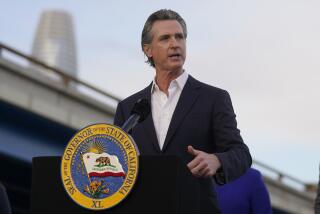Gasoline price surge comes at bad time
- Share via
Gasoline prices have risen at an unprecedented pace this year, pushing the average pump price in San Francisco and a few other California towns past the $3 mark for regular gas. In Southern California, many filling stations also have passed that benchmark.
With fuel costs soaring still faster in other parts of the U.S. -- a fresh Energy Department survey today will show just how fast -- experts say the surge could knock the wheels off an economic recovery before it even gets underway.
Market watchers differ on what’s pushing up the cost of fuel and the oil from which it is made, but they agree that this is a particularly bad time for another leap in energy prices.
“The gasoline rise is like a tax we feel very painfully every time we go to a gas station,” said Ed Leamer, director of the UCLA Anderson Forecast. For consumers struggling to regain their confidence, “it adds uncertainty. It will tend to retard the economic recovery and make it less powerful.”
For Roy Persinko of Mar Vista, it hardly matters that gasoline prices remain well below last year’s record levels. As a home repairman, Persinko has endured the housing market collapse and weathered fearful customers’ calling him only for work that can’t be avoided. Then last month, Persinko’s truck was stolen; police recovered it, but $20,000 in parts and tools was gone.
“They took everything,” Persinko said. “They left me with a hard hat that wasn’t even mine and a jar of peanut butter. They even stole an old telephone book out from under the seat.”
Persinko has watched the cost of filling his truck rise from about $70 in January to more than $100 now.
“That really opened my eyes,” said Persinko, 51. “It’s speculators driving the commodities market, or the oil companies are pillaging again. Last time it happened, it helped bring the whole economy down. Now it’s happening again.”
Since early January, the average price of a gallon of regular gasoline nationally has climbed from $1.684, the lowest point in four years, to $2.624 on June 8, up 56%, according to the Energy Department’s weekly survey of filling stations. The pace is faster than any ever recorded, analysts say.
It’s also unusual in that California was a relative foot dragger instead of playing its usual role as the place where prices increase first and fastest.
California prices have risen 54.3%, to $2.891 from $1.874 a gallon, during the same period. Other areas have seen prices leap by higher rates: up 54.9% on the East Coast, 56% in the Midwest, 59.9% on the Gulf Coast and 68.4% in the Rocky Mountain states.
At the same time, oil futures rose to just over $68 a barrel on the New York Mercantile Exchange from nearly $49.
The energy price explosion baffles some analysts who have been saying for weeks that prices weren’t supported by market fundamentals. There’s no economic boom creating more demand and no lack of crude oil supplies.
“The extent of this increase has been unjustifiable,” said Tom Kloza, analyst for the Oil Price Information Service in Wall, N.J. “This rally is like that stuff on Donald Trump’s head. It’s all froth. It’s just not real.”
The price movement reminds Kloza of last summer’s, when gas rose to record highs above $4.58 a gallon in California and $4.11 nationally.
He calls it another risky bet by speculators, who bought heavily last year only to see oil plummet from more than $147 a barrel in July to less than $40 in mid-January.
“There’s a big trading pool of money going into oil. It’s patient money. It might be parked there for a few years. It’s seen as the great investment hedge against a weak dollar,” said Kloza, who nevertheless thinks the price of gasoline won’t reach $3 a gallon nationally this year.
Phil Flynn, senior market analyst for Alaron Trading Co. in Chicago, said energy prices were being driven by the devil the Obama administration has chosen to dance with to get out of the recession: big spending and big deficits that have pummeled the value of the dollar relative to foreign currencies and driven more investors into oil, raising its price and effect on gasoline.
“Washington has had much more influence this time,” Flynn said. “If they cut spending and raised interest rates, oil would drop and gasoline would drop. But what kind of recovery would we have if there wasn’t all of this bailout money?”
Refinery owners have played a big role by choosing to refine less, said Patrick DeHaan, senior petroleum analyst for Gasbuddy.com, a national system of price-tracking websites. In the Midwest, scene of some of the biggest price hikes, “refineries have been operating at 80% to 85% of capacity instead of the usual 90% to 95%,” DeHaan said.
It’s wearing thin on Lisa Nguyen, who helps manage a family catering business called the Carbon Grill. Nguyen bought her first house in November and is already trying to refinance to lower the mortgage payments, in part because she won’t raise prices on loyal customers she says are in much worse shape than she is.
Nguyen and her family drive an average of 500 miles a week for supplies and to go to catering jobs, special events and farmers markets. The pump prices “have been nerve-racking,” she said.
“Yesterday it cost $50 to fill up,” Nguyen said. “The price is going up so fast that it makes you cringe.”
--
More to Read
Inside the business of entertainment
The Wide Shot brings you news, analysis and insights on everything from streaming wars to production — and what it all means for the future.
You may occasionally receive promotional content from the Los Angeles Times.











